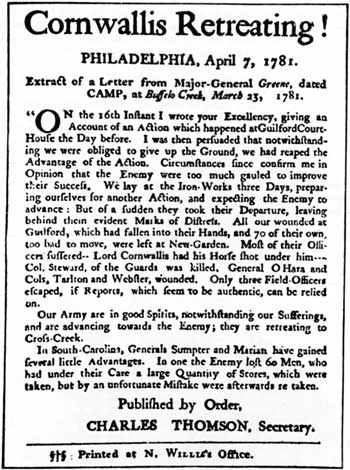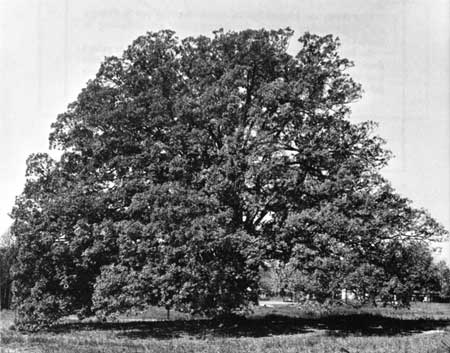|
GUILFORD COURTHOUSE National Military Park |
 |
The Road to Yorktown
The Battle of Guilford Courthouse was the climax of a hard campaign of 2 months in the dead of winter. Cornwallis had previously destroyed his baggage train in order that he might pursue the Americans more rapidly during the race for the river fords. Now, after their victory at Guilford, the British found themselves in an almost desperate situation. Shoes, clothing, ammunition medicines, food—all the myriad supplies and equipment necessary for successful campaigning—were either entirely expended or dangerously low. The men were tired and their morale was none too good. Rest, reorganization, and refitting were essential, and for this Cornwallis required time and safety. The English were, therefore, forced to retreat in order that they might establish immediate contact with their base of operations at Charleston.
SOUTHERN CAMPAIGN AFTER THE BATTLE OF GUILFORD COURTHOUSE
| 1781 | |
| March 18 | Cornwallis starts his march to Wilmington. |
| March & April | Greene follows him for 50 miles, then returns to South Carolina. |
| April 25 | Battle of Hobkirk's Hill. |
| April & May | Cornwallis marches from Wilmington to Virginia. |
| May & June | Greene besieges Ninety-Six. |
| Sept. 8 | Battle of Eutaw Springs. British withdraw into Charleston. |

(click on image for an enlargement in a new window)

Reproduction of a Philadelphia broadside,
outlining Greene's activities in the South.
In the Emmet
Collection, New York Public Library.
After the battle, Cornwallis headed southeast. His first destination was Cross Creek near Fayetteville. The settlers in that region, almost all Highland Scots, were largely loyalists, and it was thought that they would provide the retreating army with food and a safe haven for reorganization. It was also thought that water communication with Charleston could be established by way of the Cape Fear River. But the river was not navigable to Cross Creek, nor was food available. Of necessity, then, the march was continued to Wilmington, where the sea route to Charleston was open, and where all needed supplies could be delivered without difficulty.

The Liberty Oak. On the morning before the battle,
General Greene's men camped around this tree. It stands today as a
living reminder of the battle fought here for American
liberty.
In the meantime, Greene eagerly grasped the opportunity presented by the action at Guilford Courthouse and the retreat of his adversary. He followed Cornwallis part of the way to Cross Creek, seeking in his turn to bring on a contest. This Cornwallis avoided. After a few days of fruitless pursuit, Greene suddenly changed direction. He led his army into South Carolina and bent his energies to the redemption of that State.
In this purpose he was successful. At the end of the summer he had lost most of his battles, as he had lost at Guilford. But after each battle the British were compelled to evacuate one or more of their posts. Finally, in September, after the Battle of Eutaw Springs, the British were driven from the whole State and continued to hold only the city of Charleston, against which Greene was powerless for want of an assisting naval force.
Cornwallis remained at Wilmington for about a month, going thence to Virginia where he united with an army under Benedict Arnold and operated over much of the southern part of the State during the first part of the summer. Early in August he established himself at Yorktown, where he was forced to surrender on October 19.
The importance of the Battle of Guilford Courthouse lies not in the battle itself, nor in the numbers involved, the tactics employed, nor in the casualties inflicted upon either side. Rather its importance is in the effects which flowed from it, and in the fact that in winning, Cornwallis was the ultimate loser.
Thus Guilford Courthouse is important in the immediate result of rendering North Carolina safe and in the larger result of freeing Greene's hands for reconquest to the southward. Broken was the grand British plan of campaign which would have detached the Southern Colonies from the Colonies to the north. Cornwallis was driven into Virginia without making secure his rear. Greene had lost a battle but won a campaign.

|
|
Last Modified: Mon, Dec 2 2002 10:00:00 am PDT |


